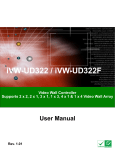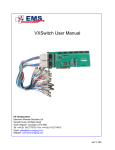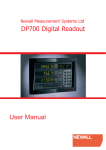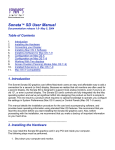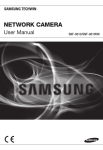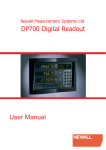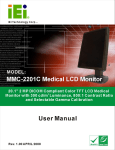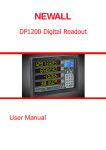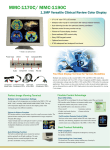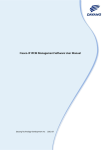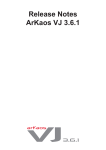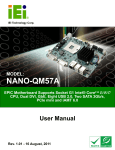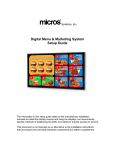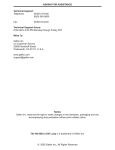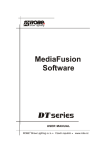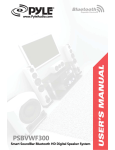Download VWBOX-122/133 Video Wall Controller
Transcript
iVu4 & iVu9 Standalone Video Wall Controller MODEL: V Video Wall Controller Supports 2x2 and 3x3 LCD Panel Array User Manual U.K Head Office & Sales Center Electronic Modular Solutions Ltd. Kendal House, 20 Blaby Rd., S. Wigston, Leics., LE18 4SB, England Tel: +44 (0)116 2775730, Fax: +44 (0)116 2774973 email: [email protected] Web: http://www.ems-imaging.com Rev. 1.00 October, 2008 Page i iVu4/9 Standalone Video Wall Controller Revision Date Version Changes October, 2008 1.00 Initial release Page ii iVu4/9 Standalone Video Wall Controller Copyright COPYRIGHT NOTICE The information in this document is subject to change without prior notice in order to improve reliability, design and function and does not represent a commitment on the part of the manufacturer. In no event will the manufacturer be liable for direct, indirect, special, incidental, or consequential damages arising out of the use or inability to use the product or documentation, even if advised of the possibility of such damages. This document contains proprietary information protected by copyright. All rights are reserved. No part of this manual may be reproduced by any mechanical, electronic, or other means in any form without prior written permission of the manufacturer. TRADEMARKS All registered trademarks and product names mentioned herein are used for identification purposes only and may be trademarks and/or registered trademarks of their respective owners. Page iii iVu4/9 Standalone Video Wall Controller Manual Conventions WARNING! Warnings appear where overlooked details may cause damage to the equipment or result in personal injury. Warnings should be taken seriously. Warnings are easy to recognize. The word “warning” is written as “WARNING,” both capitalized and bold and is followed by text. The text is the warning message. A warning message is shown below: WARNING: This is an example of a warning message. Failure to adhere to warning messages may result in permanent damage to the iVu4/9 or personal injury to the user. Please take warning messages seriously. CAUTION! Cautionary messages should also be heeded to help reduce the chance of losing data or damaging the iVu4/9. Cautions are easy to recognize. The word “caution” is written as “CAUTION,” both capitalized and bold and is followed. The text is the cautionary message. A caution message is shown below: CAUTION: This is an example of a caution message. Failure to adhere to cautions messages may result in permanent damage to the iVu4/9. Please take caution messages seriously. Page iv iVu4/9 Standalone Video Wall Controller NOTE: These messages inform the reader of essential but non-critical information. These messages should be read carefully as any directions or instructions contained therein can help avoid making mistakes. Notes are easy to recognize. The word “note” is written as “NOTE,” both capitalized and bold and is followed by text. The text is the cautionary message. A note message is shown below: NOTE: This is an example of a note message. Notes should always be read. Notes contain critical information about the iVu4/9. Please take note messages seriously. Page v iVu4/9 Standalone Video Wall Controller Packing List NOTE: If any of the components listed in the checklist below are missing, please do not proceed with the installation. Contact the EMS reseller or vendor you purchased the iVu4/9 from or contact an EMS sales representative directly. To contact an EMS sales representative, please send an email to [email protected] . The items listed below should all be included in the iVu4/9 package. 1 x iVu4/9 1 x Power cord 1 x Power adapter 1 x Remote control 1 x RS-232 cable 1 x DVI-I dual link cable 1 x User manual and utilities CD 2 x Mount bracket 1 x Screw set Images of the above items are shown in Chapter 3. Page vi iVu4/9 Standalone Video Wall Controller Table of Contents 1 INTRODUCTION.......................................................................................................... 1 1.1 INTRODUCTION .......................................................................................................... 2 1.2 BENEFITS ................................................................................................................... 2 1.3 FEATURES .................................................................................................................. 2 1.4 EXTERNAL INTERFACES, SWITCHES AND LEDS ......................................................... 3 1.5 TECHNICAL SPECIFICATIONS ...................................................................................... 5 2 SYSTEM OVERVIEW.................................................................................................. 7 2.1 DIMENSIONS .............................................................................................................. 8 2.1.1 iVu4 Dimensions................................................................................................ 8 2.1.2 iVu9 Dimensions................................................................................................ 9 2.2 EXTERNAL OVERVIEW ............................................................................................. 10 2.2.1 Front Panel ...................................................................................................... 10 2.2.2 Rear Panel ........................................................................................................11 2.2.2.1 DVI Connector.......................................................................................... 12 2.2.2.2 Serial Port.................................................................................................. 13 3 UNPACKING LIST ..................................................................................................... 15 3.1 ANTI-STATIC PRECAUTIONS ...................................................................................... 16 3.2 UNPACKING PRECAUTIONS....................................................................................... 16 3.3 PACKING LIST .......................................................................................................... 17 3.4 OPTIONAL ITEMS ...................................................................................................... 18 4 INSTALLATION ......................................................................................................... 19 4.1 INSTALLATION OVERVIEW ........................................................................................ 20 4.1.1 Four Panel Overview....................................................................................... 20 4.1.2 16 Panel Overview........................................................................................... 21 4.2 INSTALLATION STEPS ............................................................................................... 22 4.3 INSTALL LCD PANELS.............................................................................................. 22 4.4 MOUNTING............................................................................................................... 22 4.5 CONNECT CABLES.................................................................................................... 23 Page vii iVu4/9 Standalone Video Wall Controller 4.5.1 Connect the Video Source and iVu4/9 ............................................................. 24 4.5.2 Connect the RS-232 Cable to the iVu4/9 (Optional) ....................................... 25 4.5.3 Connect the iVu4/9 to the Power Supply ......................................................... 26 4.6 RESOLUTION AND DISPLAY MODE ........................................................................... 27 4.7 BEZEL COMPENSATION ............................................................................................ 27 5 OSD FUNCTIONS....................................................................................................... 29 5.1 SMARTOSD.............................................................................................................. 30 5.1.1 Pre-installation Notice ..................................................................................... 30 5.1.2 Installing the smartOSD .................................................................................. 30 5.1.3 Using the smartOSD ........................................................................................ 35 5.1.3.1 Control Panel ............................................................................................ 36 5.1.3.2 Read OSD ................................................................................................. 38 5.1.3.3 Power Control ........................................................................................... 39 5.1.3.4 PC Setting ................................................................................................. 40 5.1.3.5 About Page ................................................................................................ 41 5.2 USING THE OSD....................................................................................................... 42 5.2.1 OSD Buttons..................................................................................................... 42 5.2.2 OSD Lock ......................................................................................................... 42 5.2.3 OSD Menu........................................................................................................ 43 5.2.3.1 Bezel Control ............................................................................................ 44 5.2.3.2 Input Resolution........................................................................................ 45 5.2.3.3 Output Resolution ..................................................................................... 46 5.2.3.4 Synchronization ........................................................................................ 47 5.2.3.5 Hardware Information............................................................................... 48 5.2.3.6 Model Information .................................................................................... 49 5.2.4 Remote Control ................................................................................................ 49 6 TROUBLESHOOTING AND MAINTENANCE ..................................................... 51 6.1 ANTI-STATIC PRECAUTIONS ...................................................................................... 52 6.2 MAINTENANCE OVERVIEW....................................................................................... 53 6.3 TROUBLESHOOTING ................................................................................................. 53 6.3.1 No Image on One Monitor ............................................................................... 53 6.3.1.1 Check Monitor Power ............................................................................... 53 6.3.1.2 Check Panel Video Connection................................................................. 53 Page viii iVu4/9 Standalone Video Wall Controller 6.3.2 No Image Two or Three Monitors .................................................................... 54 6.3.3 No Image on Any Monitor................................................................................ 54 6.3.3.1 Check Video Box Power ........................................................................... 54 6.3.3.2 Check Source Video Connection .............................................................. 54 A RS-232 SETUP............................................................................................................. 55 A.1 SETUP...................................................................................................................... 56 A.2 PACKET FORMAT ..................................................................................................... 56 A.3 COMMAND REFERENCE ........................................................................................... 57 A.3.1 Get Display Status ........................................................................................... 58 A.3.2 Get Factory Defaults ....................................................................................... 59 A.3.3 Set Mask Control ............................................................................................. 60 A.3.4 Set Display Mode............................................................................................. 61 A.3.5 Set Display Resolution..................................................................................... 61 A.3.6 Set Input Source............................................................................................... 62 A.3.7 Set Power Control ........................................................................................... 62 A.3.8 Set to Default ................................................................................................... 63 A.3.9 Set OSD Mode ................................................................................................. 63 B TERMINOLOGY........................................................................................................ 64 C HAZARDOUS MATERIALS DISCLOSURE ......................................................... 66 C.1 HAZARDOUS MATERIALS DISCLOSURE TABLE FOR IPB PRODUCTS CERTIFIED AS ROHS COMPLIANT UNDER 2002/95/EC WITHOUT MERCURY ....................................... 67 Page ix iVu4/9 Standalone Video Wall Controller List of Figures Figure 1-1: iVu4/9 ...........................................................................................................................2 Figure 1-2: iVu4 Overview (Front View) .......................................................................................3 Figure 1-3: iVu9 Overview (Front View) .......................................................................................4 Figure 1-4: Overview (Rear View)..................................................................................................4 Figure 1-5: Overview (Rear View)..................................................................................................5 Figure 2-1: iVu4 Video Box Dimensions ......................................................................................8 Figure 2-2: iVu9 Video Box Dimensions ......................................................................................9 Figure 2-3: iVu4 Front Panel .......................................................................................................10 Figure 2-4: iVu9 Front Panel .......................................................................................................11 Figure 2-5: iVu4 Rear Panel ........................................................................................................12 Figure 2-6: iVu9 Rear Panel ........................................................................................................12 Figure 2-7: COM1 Pinout Locations............................................................................................14 Figure 4-1: Four Panel Setup.......................................................................................................20 Figure 4-2: 9 Panel Setup.............................................................................................................21 Figure 4-3: Mounting Brackets....................................................................................................23 Figure 4-4: Cable Connections....................................................................................................24 Figure 4-5: Video Source .............................................................................................................25 Figure 4-6: iVu4/9 Video Input.....................................................................................................25 Figure 4-7: Serial Device Connector...........................................................................................26 Figure 4-8: Display Mode .............................................................................................................27 Figure 4-9: Mask Calculation.......................................................................................................28 Figure 5-1: smartOSD Language Selection ...............................................................................31 Figure 5-2: smartOSD Welcome Screen.....................................................................................31 Figure 5-3: smartOSD Installation Directory..............................................................................32 Figure 5-4: smartOSD Start Menu Folder ...................................................................................32 Figure 5-5: smartOSD Additional Tasks.....................................................................................33 Figure 5-6: smartOSD Ready to Install .......................................................................................33 Figure 5-7: smartOSD Installing..................................................................................................34 Figure 5-8: smartOSD Installation Complete .............................................................................34 Figure 5-9: smartOSD Control Panel ..........................................................................................36 Page x iVu4/9 Standalone Video Wall Controller Figure 5-10: smartOSD Read OSD ..............................................................................................38 Figure 5-11: smartOSD Power Control .......................................................................................39 Figure 5-12: smartOSD PC Setting .............................................................................................40 Figure 5-13: smartOSD About Page............................................................................................41 Figure 5-14: OSD Buttons............................................................................................................42 Figure 5-15: Bezel Control ...........................................................................................................44 Figure 5-16: Input Resolution......................................................................................................45 Figure 5-17: Display Menu ...........................................................................................................46 Figure 5-18: Synchronization ......................................................................................................47 Figure 5-19: Hardware Information .............................................................................................48 Figure 5-20: Input Select..............................................................................................................49 Figure 5-21: Remote Control .......................................................................................................50 Page xi iVu4/9 Standalone Video Wall Controller List of Tables Table 1-1: Technical Specifications..............................................................................................6 Table 2-1: DVI Connector Pinouts...............................................................................................13 Table 2-2: COM1 Pinouts .............................................................................................................13 Table 3-1: Package List Contents ...............................................................................................18 Table 3-2: Optional Items.............................................................................................................18 Table 4-1: Input and Output Resolution .....................................................................................27 Table 5-1: smartOSD Menu Structure.........................................................................................35 Table 5-2: OSD Menu Structure...................................................................................................43 Table 6-1: RS-232 Setup...............................................................................................................56 Table 6-2: n-Byte Data Output Format........................................................................................56 Table 6-3: Get Display Status ......................................................................................................58 Table 6-4: Get Factory Defaults...................................................................................................59 Table 6-5: Set Mask Control ........................................................................................................60 Table 6-6: Set Display Mode ........................................................................................................61 Table 6-7: Set Display Resolution...............................................................................................61 Table 6-8: Set Input Source .........................................................................................................62 Table 6-9: Set Power Control.......................................................................................................62 Table 6-10: Set to Default.............................................................................................................63 Table 6-11: Set OSD Mode ...........................................................................................................63 Page xii iVu4/9 Standalone Video Wall Controller Chapter 1 1 Introduction Page 1 iVu4/9 Standalone Video Wall Controller 1.1 Introduction Figure 1-1: iVu4/9 Standalone The EMS iVu4/9 video wall controller box is for displaying a single video input on an array of monitors, implementing a large display without the inherent high costs of a single large monitor. The EMS iVu4/9 is for large displays where high definition video output is also essential. The video wall controller accepts a single DVI input. The EMS iVu4/9 requires a high-resolution digital video input signal, which is split directly over the panels in the array, with no image scaling or adjustment, ensuring maximum image accuracy. The EMS iVu4/9 video controller box can be controlled remotely using the included remote control or from a computer with an RS-232 serial port. 1.2 Benefits The benefits of the iVu4/9 include: Accurate, high-definition image Silent operation Simple setup Cheaply implements a large display 1.3 Features The features of the iVu4/9 include: DVI video input Four/nine DVI video outputs Support for up to 1920 x 1200 output resolution Multiple video output combinations including full video wall mode, clone mode and vertical replication mode Bezel control compensates for gaps between monitors Page 2 iVu4/9 Standalone Video Wall Controller 1.4 External Interfaces, Switches and LEDs External interfaces, switches and LEDs are accessed through the iVu4/9 video wall controller chassis include: 4 x DVI outputs (9 for iVu9) 1 x DVI input 4 x DVI output LED indicators (9 for iVu9) 1 x OSD menu keypad 1 x Power input 1 x Power LED indicator 1 x RS-232 serial communications port 1 x Sync in 1 x Sync out 1 x Video in LED indicator Figure 1-2 and Figure 1-3 show the buttons and LED indicators on the front panel. Figure 1-2: iVu4 Overview (Front View) Page 3 iVu4/9 Standalone Video Wall Controller Figure 1-3: iVu9 Overview (Front View) Figure 1-4 and Figure 1-5 show the external peripheral interface connectors on the rear panel. Figure 1-4: Overview (Rear View) Page 4 iVu4/9 Standalone Video Wall Controller Figure 1-5: Overview (Rear View) 1.5 Technical Specifications iVu4/9 video box features are listed in Table 1-1. See Chapter 2 for details. Specification Detail Model Name iVu4/9 1. Multiple viewing modes Main Features 2. Software OSD 3. Remote control 4. Bezel masking Inputs Outputs Dimensions (H x W x D) Cooling DVI iVu4 – 4 x DVI iVu9 – 9 x DVI iVu4 – 47 mm x 230 mm x 178 mm iVu9 – 47 mm x 295 mm x 188 mm Fanless 1920x1080, 1920x1200, 2048x768, 2560x1024, Input Resolution 3840x1080, 3840x1200, 2048x1536, 2560x2048, 3840x2160, 3840x2400 Output Resolution 1024x768, 1280x1024, 1920x1080, 1920x1200 Power Adapter Input 90 VAC to 264 VAC / 47 Hz to 63 Hz Page 5 iVu4/9 Standalone Video Wall Controller Specification Detail Power Adapter Output 12 V DC Safety and Emission CCC, CE, FCC Temperature 0ºC – 40ºC Power Consumption iVu4 – 10 W iVu9 – 17 W Table 1-1: Technical Specifications Page 6 iVu4/9 Standalone Video Wall Controller Chapter 2 2 System Overview Page 7 iVu4/9 Standalone Video Wall Controller 2.1 Dimensions The dimensions of the iVu4/9 are listed in the sections below. 2.1.1 iVu4 Dimensions Height: 47 mm Width: 230 mm Depth: 178 mm Figure 2-1: iVu4 Video Box Dimensions Page 8 iVu4/9 Standalone Video Wall Controller 2.1.2 iVu9 Dimensions Height: 47 mm Width: 295 mm Depth: 188 mm Figure 2-2: iVu9 Video Box Dimensions Page 9 iVu4/9 Standalone Video Wall Controller 2.2 External Overview This section gives and overview of the connectors, switches and indicators on the iVu4/9. 2.2.1 Front Panel The front panel has the following buttons and indicators (shown in Figure 2-3 and Figure 2-4 below): Power indicator LED Video output LEDs Video input LED OSD menu keypad Figure 2-3: iVu4 Front Panel Page 10 iVu4/9 Standalone Video Wall Controller Figure 2-4: iVu9 Front Panel 2.2.2 Rear Panel The rear panel has the following connectors, switches and indicators (shown in Figure 2-5 and Figure 2-6 below): 4 x DVI video outputs (9 on the iVu9) 1 x DVI video input 1 x Power input 1 x Power switch 1 x RS-232 serial communications port 1x Sync in 1 x Sync out Page 11 iVu4/9 Standalone Video Wall Controller Figure 2-5: iVu4 Rear Panel Figure 2-6: iVu9 Rear Panel 2.2.2.1 DVI Connector CN Label: DVI1 CN Type: DVI connector CN Location See Figure 2-5 CN Pinouts: See Table 2-1 The 24-pin Digital Visual Interface (DVI) connector connects to high-speed, high-resolution digital displays. The DVI-I connector supports both digital and analog signals. Page 12 iVu4/9 Standalone Video Wall Controller PIN Signal Name Pin # Signal Name Pin # Signal Name 1 TMDS Data2- 9 TMDS Data1- 17 TMDS Data0- 2 TMDS Data2+ 10 TMDS Data1+ 18 TMDS Data0+ 3 GND 11 GND 19 GND 4 N/C 12 NC 20 NC 5 N/C 13 NC 21 NC 6 DDC Clock [SCL] 14 PVDD1 22 GND 7 DDC Data [SDA] 15 GND 23 TMDS Clock + 8 Analog vertical sync 16 GND 24 TMDS Clock - C1 Analog Red C2 Analog Green C3 Analog Blue C4 Analog Horizontal Sync C5 Analog GND Table 2-1: DVI Connector Pinouts 2.2.2.2 Serial Port CN Label: COM1 CN Type: RS-232 serial connector CN Location: See Figure 2-5 CN Pinouts: See Table 2-2 and Figure 2-7 The RS-232 serial connector provides serial connections in RS-232 mode. PIN DESCRIPTION PIN DESCRIPTION 1 DCD1 2 DSR1 3 RX1 4 RTS1 5 TX1 6 CTS1 7 DTR1 8 RI1 9 GND Table 2-2: COM1 Pinouts Page 13 iVu4/9 Standalone Wall Controller Figure 2-7: COM1 Pinout Locations Page 14 iVu4/9 Standalone Video Wall Controller Chapter 3 3 Unpacking List Page 15 iVu4/9 Standalone Video Wall Controller 3.1 Anti-static Precautions WARNING: Failure to take ESD precautions during the installation of the iVu4/9 may result in permanent damage to the iVu4/9 and severe injury to the user. Electrostatic discharge (ESD) can cause serious damage to electronic components, including the iVu4/9. Dry climates are especially susceptible to ESD. It is therefore critical that whenever the iVu4/9, or any other electrical component is handled, the following anti-static precautions are strictly adhered to. Wear an anti-static wristband: - Wearing a simple anti-static wristband can help to prevent ESD from damaging the board. Self-grounding:- Before handling the board touch any grounded conducting material. During the time the board is handled, frequently touch any conducting materials that are connected to the ground. Use an anti-static pad: - When configuring the iVu4/9, place it on an antic-static pad. This reduces the possibility of ESD damaging the iVu4/9. Only handle the edges of the PCB:- When handling the PCB, hold the PCB by the edges. 3.2 Unpacking Precautions When the iVu4/9 is unpacked, please do the following: Follow the anti-static precautions outlined in Section 3.1. Make sure the packing box is facing upwards so the iVu4/9 does not fall out of the box. Make sure all the components shown in Section 3.3 are present. Page 16 iVu4/9 Standalone Video Wall Controller 3.3 Packing List NOTE: If some of the components listed in the checklist below are missing, please do not proceed with the installation. Contact the EMS reseller or vendor that sold the iVu4 / 9 from or contact an EMS sales representative directly. To contact an EMS sales representative, please send an email to [email protected] The iVu4/9 is shipped with the following components: No. Description 1 iVu4/9 1 Power cord 1 Power adapter 1 Remote control 1 Mounting brackets 1 Screw kit 1 User manual and utilities CD Image Page 17 iVu4/9 Standalone Video Wall Controller No. Description 2 RS-232 cable 1 DVI cable Image Table 3-1: Package List Contents 3.4 Optional Items The following optional items are available for the iVu4/9: Description DVI cable Table 3-2: Optional Items Page 18 Image iVu4/9 Standalone Video Wall Controller Chapter 4 4 Installation Page 19 iVu4/9 Standalone Video Wall Controller 4.1 Installation Overview The iVu4 supports a 4-panel setup and the iVu9 supports a 9-panel setup. 4.1.1 Four Panel Overview The implementation of a 4-panel array is shown in Figure 4-1 below. Figure 4-1: Four Panel Setup Page 20 iVu4/9 Standalone Video Wall Controller 4.1.2 16 Panel Overview The implementation of a 9-panel array is shown in Figure 4-2 below. Figure 4-2: 9 Panel Setup Page 21 iVu4/9 Standalone Video Wall Controller 4.2 Installation Steps To install the iVu4/9 please follow the installation steps below: Step 1: Install the LCD panels. Step 2: Mount the iVu4/9. Step 3: Connect DVI cables, video input cable, RS-232 cable and power adapter to the iVu4/9. Step 4: Adjust the screen resolution output settings. Step 5: Adjust the iVu4/9 bezel settings to align the images.Step0: 4.3 Install LCD Panels The LCD panels are installed as a square array, with two rows and two columns for the iVu4 and three rows and three columns for the iVu9. Recommended installation procedures are to Use all identical monitors Minimize gaps between panels for the best image Maintain consistent horizontal gaps between monitors Maintain consistent vertical gaps between monitors 4.4 Mounting The iVu4/9 must be placed on a table, desk or other firm surface. Optionally, the iVu4/9 can be mounted using the included mounting brackets. The installation location must be: Out of direct sunlight Without anything on top of it On a firm surface Away from moisture and liquids Page 22 iVu4/9 Standalone Video Wall Controller Figure 4-3: Mounting Brackets 4.5 Connect Cables The cables that need to be attached to the iVu4 are listed below and their connections are shown in Figure 4-4 (connections for the iVu9 are similar): Video input cable – from a DVI video source Video output cables – attached to the LCD panels or another iVu4/9. Make sure the cables are connected to the correct monitors as shown in Figure 4-4. Power cable – from the power adapter RS-232 cable (optional) – connected to a computer with smartOSD software installed Page 23 iVu4/9 Standalone Video Wall Controller Figure 4-4: Cable Connections 4.5.1 Connect the Video Source and iVu4/9 Connect the video source to the iVu4/9. If the video source is a computer with the smartOSD software installed, that computer can be used to adjust the monitor settings without using the OSD. The video source connects directly to the iVu4/9 through a DVI cable. To connect the video source to the iVu4/9, follow the steps below. Page 24 iVu4/9 Standalone Video Wall Controller Step 1: Attach the DVI cable to the video source. Figure 4-5: Video Source Step 2: Attach the video cable to the iVu4/9.Step 0: Figure 4-6: iVu4/9 Video Input 4.5.2 Connect the RS-232 Cable to the iVu4/9 (Optional) The iVu4/9 has a male DB-9 connector on the rear panel. The RS-232 cable connects to a computer that has the smartOSD software installed. This enables the computer to control the screen setup. This computer does not need to be the video source. If the video source is from a PC the image screen setup can be controlled through Page 25 iVu4/9 Standalone Video Wall Controller the DVI or VGA cable. Follow the steps below to connect a serial device to the iVu4/9. Step 1: Locate the DB-9 connector. The location of the DB-9 connector is shown in Chapter 2. Step 2: Insert the serial connector. Insert the DB-9 connector of a serial device into the DB-9 connector on the external peripheral interface. See Figure 4-7. Figure 4-7: Serial Device Connector Step 3: Secure the connector. Secure the serial device connector to the external interface by tightening the two retention screws on either side of the connector.Step0: 4.5.3 Connect the iVu4/9 to the Power Supply Connect the included PSU into an AC power supply then connect the PSU to the iVu4/9. The figure below shows the typical setup. There is no power switch, and the iVu4/9 turns on as soon as it is connected to the PSU. Page 26 iVu4/9 Standalone Video Wall Controller 4.6 Resolution and Display Mode The iVu4/9 display mode is automatically selected according to the input resolution. The display modes are shown in Figure 4-8 and the input resolution settings are shown in Table 4-1. Figure 4-8: Display Mode Input Resolution Mode Video Output Resolution 1920x1080@60 Hz Clone – same image 1920x1080@50 Hz 1920x1200@60 Hz on all monitors 1920x1200@50 Hz 2048x768@60 Hz Split – same image 1024x768@60 Hz 2560x1024@60 Hz shows on each row or 1280x1024@60 Hz 3840x1080@40 Hz monitors 1920x1080@50 Hz 1920x1200@50 Hz 3840x1200@40 Hz 2048x1536@58 Hz Video wall – image 1024x768@60 Hz 2560x2048@50 Hz split over all monitors 1280x1024@60 Hz 3840x2160@24 Hz 1920x1080@50 Hz 3840x2400@25 Hz 1920x1200@50 Hz Table 4-1: Input and Output Resolution 4.7 Bezel Compensation The bezel compensation setting compensates for the gaps between monitors in the video wall array. The bezel compensation sizes the image slightly larger than the visible screen Page 27 iVu4/9 Standalone Video Wall Controller to make the images on adjacent monitors line-up correctly. The bezel settings can be set using the smartOSD (Section 5.1) or OSD menu (Section 5.2). To calculate the appropriate mask value, use the formula shown in Figure 4-9 below: Figure 4-9: Mask Calculation Page 28 iVu4/9 Standalone Video Wall Controller Chapter 5 5 OSD Functions Page 29 iVu4/9 Standalone Video Wall Controller 5.1 smartOSD EMS smartOSD is a proprietary On-Screen-Display (OSD) software solution from EMS that enables easy, remote monitor setting adjustments in a Windows environment. EMS smartOSD delivers excellent performance and provides more flexibility than the typical OSD hardware solutions when adjusting a monitor. smartOSD also allows the screen output screen resolution and mask size to be adjusted over a DVI cable. 5.1.1 Pre-installation Notice Before installing smartOSD software, please make sure one of the following operating systems is installed: Windows 95 Windows NT 4.0 Windows 98 Windows 2000 Windows 2003 Windows XP Windows Vista 5.1.2 Installing the smartOSD To install the software, please follow the steps below: Step 1: Follow the instructions from the interactive installer to install the EMS smartOSD on the system. Step 2: Insert the installation disk that came with the system and open the installation file. Page 30 iVu4/9 Standalone Video Wall Controller Step 3: The language selection window appears (Figure 5-1). Figure 5-1: smartOSD Language Selection Step 4: Select the preferred language then click OK. Step 5: The welcome screen shown below appears (Figure 5-2). Figure 5-2: smartOSD Welcome Screen Step 6: Click NEXT to continue. Page 31 iVu4/9 Standalone Video Wall Controller Step 7: The Select Destination Folder window appears (Figure 5-3). Figure 5-3: smartOSD Installation Directory Step 8: Change the installation directory if necessary. Click NEXT to continue. Step 9: The Select Start Menu Folder option window appears (Figure 5-4). Figure 5-4: smartOSD Start Menu Folder Step 10: Choose a new name or folder for the Start Menu entry if necessary. Click NEXT to continue. Page 32 iVu4/9 Standalone Video Wall Controller Step 11: The Additional Tasks window appears (Figure 5-5). Figure 5-5: smartOSD Additional Tasks Step 12: Check the extra items that should be added (optional). Click NEXT to continue. Step 13: The Ready to Install windows appears (Figure 5-6). Figure 5-6: smartOSD Ready to Install Step 14: Confirm the installation by clicking INSTALL in the screen above. Page 33 iVu4/9 Standalone Video Wall Controller Step 15: The Installation Progress window appears, showing the progress of the software installation (Figure 5-7). Figure 5-7: smartOSD Installing Step 16: The Completing the iVu Setup Wizard window appears (Figure 5-8) Figure 5-8: smartOSD Installation Complete Page 34 iVu4/9 Standalone Video Wall Controller Step 17: Click FINISH to close the installation wizard. Step0: 5.1.3 Using the smartOSD The table below shows the smartOSD menu structure (Table 5-1). Menu Options Interface Interface Selection Display Display Resolution Display Mode Mask Setting Setting Digital I/O Test Input Source Power Factory Reset OSD Lock OSD Rotation About Company Contact Details Table 5-1: smartOSD Menu Structure Page 35 iVu4/9 Standalone Video Wall Controller 5.1.3.1 Control Panel The control panel page presents all the adjustable settings for the iVu4/9. Figure 5-9: smartOSD Control Panel Bezel Control The Bezel Control options allow the images to be adjusted to compensate for the gaps between monitors in the video array. Off The images are shown without any adjustments On The value of X and the value of Y can be adjusted to compensate for gaps between monitors (for single video box) ML The left side is fixed and the right side changes when adjustments are made (for left side video box in a two video box setup) Page 36 iVu4/9 Standalone Video Wall Controller MR The right side is fixed and the left side changes when adjustments are made (for right side video box in a two video box setup) MUL The upper left corner is fixed and the lower right corner position changes when adjustments are made (for top left video box in a four video box setup) MUR The upper right corner is fixed and the lower left corner position changes when adjustments are made (for top right video box in a four video box setup) MLL The lower left corner is fixed and the upper right corner position changes when adjustments are made (for lower left video box in a four video box setup) MLR The lower right corner is fixed and the upper left corner position changes when adjustments are made (for lower right video box in a four video box setup) Value of X The Value of X sets the horizontal bezel compensation. Use the formula in Figure 4-9 to calculate the correct setting. Value of Y The Value of Y sets the horizontal bezel compensation. Use the formula in Figure 4-9 to calculate the correct setting. Display Mode The Display Mode option sets the video output resolution. XGA Output resolution is set to 1024 x 768 SXGA Output resolution is set to 1280 x 1024 HDTV Output resolution is set to 1920 x 1080 WUXGA Output resolution is set to 1920 x 1200 Page 37 iVu4/9 Standalone Video Wall Controller Sync The Sync option sets the syncing between multiple video boxes. On Video boxes are set to synchronize with each other Off Video boxes are not set to synchronize with each other 5.1.3.2 Read OSD The Read OSD menu displays the settings of the video wall box. Figure 5-10: smartOSD Read OSD Page 38 iVu4/9 Standalone Video Wall Controller 5.1.3.3 Power Control Figure 5-11: smartOSD Power Control Power Control The Power Control option turns the iVu4/9 on and off. On Turns on the video box Off Turns off the video box Page 39 iVu4/9 Standalone Video Wall Controller 5.1.3.4 PC Setting The PC Setting page sets the command port to use for data communication between the video box and the computer. Figure 5-12: smartOSD PC Setting COM Port The COM Port sets which serial port to use for data communication with the video box. The available serial ports depend on the system. Identify The Identify button shows a red square for each full image in the array. Page 40 Clone Mode Four red squares are displayed Split Mode Two red squares are displayed Video Wall One red square is displayed iVu4/9 Standalone Video Wall Controller 5.1.3.5 About Page The About Page shows some general information about the smartOSD. Figure 5-13: smartOSD About Page Page 41 iVu4/9 Standalone Video Wall Controller 5.2 Using the OSD The OSD menu functions are described below. 5.2.1 OSD Buttons There are several on-screen-display (OSD) control buttons oriented either vertically on the right side of the monitor front panel or on the bottom of the monitor front panel. Figure 5-14 shows a typical arrangement of OSD controls. 43 Figure 5-14: OSD Buttons Menu/Enter. Enters the OSD, selects items and sets the new values entered. Left. Moves the selection left. Right. Moves the selection right. Up. Moves the selection up. Down. Moves the selection down. Auto/Exit. Exits from any menu. 5.2.2 OSD Lock The OSD front panel buttons can be locked using the OSD lock function. To turn the OSD lock on and off, follow the steps below. (The OSD can also be locked using the smartOSD). Step 1: Push the “Right” and “Auto/Exit” buttons simultaneously for a few seconds. Step 2: The OSD display shows the current status as locked or unlocked. Step0: Page 42 iVu4/9 Standalone Video Wall Controller 5.2.3 OSD Menu The subsections below cover the layout and use of the OSD. The table below shows the OSD menu structure. Menu Options Description Bezel control BC Turns bezel on and off X Sets horizontal bezel value Y Sets vertical bezel value INX Displays horizontal input resolution INY Displays vertical input resolution MD Displays the video display mode DS Displays output setting H Displays output horizontal resolution V Displays output vertical resolution SYN Turns synchronization on and off PWR Turns off the video box FP Displays the video chip revision number CP Displays the video chip revision number FW Displays the firmware revision number Name Displays the model name SN Displays the serial number Input resolution Output resolution Synchronization Input selection Model information Table 5-2: OSD Menu Structure Page 43 iVu4/9 Standalone Video Wall Controller 5.2.3.1 Bezel Control The bezel control options are shown in Figure 5-15 and described below. 43 Figure 5-15: Bezel Control BC BC enables and disables bezel control. Bezel control adjusts the onscreen image to compensate for the gaps between monitors in the video wall array. Off On DEFAULT Onscreen image is not adjusted Onscreen image is adjusted X X sets how much the horizontal resolution of the image is adjusted to compensate for the gaps between the monitors. Use the formula in Figure 4-9 to calculate the value of X. Y Y sets how much the horizontal resolution of the image is adjusted to compensate for the gaps between the monitors. Use the formula in Figure 4-9 to calculate the value of Y. Page 44 iVu4/9 Standalone Video Wall Controller 5.2.3.2 Input Resolution The input resolution menu displays the input resolution and the automatically selected video mode. Figure 5-16: Input Resolution INX Displays the horizontal resolution of the video input signal. The following values are permissible. 1920 2048 2560 3840 INY Displays the vertical resolution of the video input signal. The following values are permissible. 768 1024 1080 1200 1536 2048 2400 Page 45 iVu4/9 Standalone Video Wall Controller MD Displays the automatically selected video display mode. 1x1 The full image is displayed on all the monitors. 2x1 The full image is displayed on each row of the video wall array 2x2 The full image is displayed across the entire array with each monitor showing a portion of the full image 5.2.3.3 Output Resolution The output resolution menu displays the resolution of the video output. Figure 5-17: Display Menu DS DS displays the name of the output resolution. Permissible values are: XGA SXGA HDTV WUXGA H H displays the horizontal resolution of the video output. Permissible values are: 1024 Page 46 iVu4/9 Standalone Video Wall Controller 1280 1920 V V displays the vertical resolution of the video output. Permissible values are: 768 1024 1080 1200 5.2.3.4 Synchronization The Synchronization menu sets the synchronization between video wall boxes in a multiple video box setup. Figure 5-18: Synchronization SYN Turns synchronization on and off. On The video boxes are connected with a cable and the displayed images are synchronized. Off The video boxes display output in the default fashion. Page 47 iVu4/9 Standalone Video Wall Controller PWR Turns the video box on and off On The video box is powered on Off The video box is powered off 5.2.3.5 Hardware Information The Hardware Information menu shows the hardware information of the video box. Figure 5-19: Hardware Information FP FP displays the firmware version of the onboard chip. CP CP displays the firmware version of the onboard chip. FW FW shows the version number of the video box firmware. Page 48 iVu4/9 Standalone Video Wall Controller 5.2.3.6 Model Information The Model Information menu shows the model name and the serial number of the video box. Figure 5-20: Input Select Model Name The first line displays the model name of the current video box. SN SN displays the serial number of the video box. 5.2.4 Remote Control The iVu4/9 comes with a remote control for easy configuration of OSD settings. Figure 5-21 shows the remote control and its function keys. 43 Page 49 iVu4/9 Standalone Video Wall Controller Figure 5-21: Remote Control Power. Turns the video box on and off. Menu. Enters the OSD, selects items and sets the new values entered. Left. Moves the selection left. Right. Moves the selection right. Up. Moves the selection up. Down. Moves the selection down. Auto/Enter. Exits from any menu. Page 50 iVu4/9 Standalone Video Wall Controller Chapter 6 6 Troubleshooting and Maintenance Page 51 iVu4/9 Standalone Video Wall Controller WARNING: Take Anti-Static precautions whenever maintenance is being carried out on the embedded system components. Failure to take anti-static precautions can cause permanent embedded system damage. 6.1 Anti-static Precautions WARNING: Failure to take ESD precautions during the installation of the iVu4/9 may result in permanent damage to the iVu4/9 and severe injury to the user. Electrostatic discharge (ESD) can cause serious damage to electronic components, including the iVu4/9. Dry climates are especially susceptible to ESD. It is therefore critical that whenever the iVu4/9, or any other electrical component is handled, the following anti-static precautions are strictly adhered to. Wear an anti-static wristband: - Wearing a simple anti-static wristband can help to prevent ESD from damaging the board. Self-grounding: - Before handling the board or opening the embedded system, touch any grounded conducting material. During the time the board is handled, frequently touch any conducting materials that are connected to the ground. Use an anti-static pad: - When configuring the iVu4/9, place it on an antic-static pad. This reduces the possibility of ESD damaging the iVu4/9. Only handle the edges of the PCB: - When handling the PCB, hold the PCB by the edges. Page 52 iVu4/9 Standalone Video Wall Controller 6.2 Maintenance Overview NOTE: There are no user-serviceable parts inside. Make sure to carefully follow all the instructions in this section to diagnose any problems. If the problem persists, email [email protected] for help from an EMS sales representative To preserve the working integrity of the iVu4/9 embedded system, the embedded system must be properly maintained. If embedded system components need replacement, the proper maintenance procedures must be followed to ensure the embedded system can continue to operate normally. 6.3 Troubleshooting This section provides some simple troubleshooting suggestions. 6.3.1 No Image on One Monitor If there is no image on one monitor, follow these steps to remedy the problem. 6.3.1.1 Check Monitor Power Step 1: Check that the monitor is turned on. Step 2: Check that the power source for the monitor is turned on. Step 3: Check that the power source has the correct power rating (check panel specifications for details). Step 4: Make sure the LCD panel power cables are securely fastened to the monitor and to the power source.Step0: 6.3.1.2 Check Panel Video Connection Check to see that the video cable is fitted correctly. Page 53 iVu4/9 Standalone Video Wall Controller Step 1: Check that the monitor is connected to the iVu4/9. Step 2: Securely attach the video cable to the panel and to the iVu4/9. Step 3: Fasten the video cable at both ends and tighten the video cable screws.Step0: 6.3.2 No Image Two or Three Monitors If there is no image on more than one of the panels, then repeat the steps in Section 6.3.1 for all of the monitors in the array. 6.3.3 No Image on Any Monitor If no image displays on any monitors, repeat the steps in Section 6.3.1 for all the monitors in the array, then try the following additional steps. 6.3.3.1 Check Video Box Power Make sure that the video box is powered on. Step 1: Check the power supply is connected to the power source. Step 2: Check that the iVu4/9 is connected to the power supply.Step0: 6.3.3.2 Check Source Video Connection Check to that the source video cable is securely connected to the iVu4/9. Step 1: Securely attach the video cable from the video source to the iVu4/9. Step 2: Fasten the video cable at both ends and tighten the video cable screws. Step 0: Page 54 iVu4/9 Standalone Video Wall Controller Appendix A A RS-232 Setup Page 55 iVu4/9 Standalone Video Wall Controller A.1 Setup The serial port is used to remotely set and get the settings from the iVu4/9. The serial port is used by user applications to change the settings of the iVu4/9 through a software interface. The serial port should be setup as indicated in Table 6-1 Description Setting Baud rate 115200 Parity Non-parity Data bit 8 Stop bit 1 Flow control None Table 6-1: RS-232 Setup A.2 Packet Format The generalized format of a single data packet on the RS-232 communications port is shown in Table 6-2. The specific setup details for all the commands are shown in the next section. Byte Function [1] The number of bytes in the signal [2] This byte indicates the command to perform [3]-[n-1]* These bytes contain the data needed for the command [n]* Checksum byte Table 6-2: n-Byte Data Output Format * n indicates the number of bytes (length) of the data packet. This value depends on the command that is being used. Page 56 iVu4/9 Standalone Video Wall Controller A.3 Command Reference This section details the commands that can be sent over the RS-232 communications port. The following commands are detailed: Get display status................................................................................... 58 Get factory defaults ................................................................................ 59 Set mask control .................................................................................... 60 Set display mode.................................................................................... 61 Set display resolution ............................................................................. 61 Set input source ..................................................................................... 62 Set power control ................................................................................... 62 Set to default .......................................................................................... 63 Set OSD mode ....................................................................................... 63 Page 57 iVu4/9 Standalone Video Wall Controller A.3.1 Get Display Status Byte Value [1] 0x08 [2] 0x03 [3] Output resolution: 0 – 1024 x 768 1 – 1360 x 768 2 – 1280 x 1024 3 – 1400 x 1500 4 – 1680 x 1050 5 – 1600 x 1200 6 – 1920 x 1200 [4] Output display mode 0 – 1 x 1 mode 1 – 1 x 2 mode 2 – 2 x 2 mode 3 – PIP mode 1 4 – PIP mode 2 5 – PIP mode 3 6 – PIP mode 4 [5] Mask control 0 – Off 1 – On [6] Horizontal mask percent 0 – 10% [7] Vertical mask percent 0 – 10% [8] Checksum 0xff-([1]+[2]+[3]+[4]+[5]+[6]+[7]+[9]) Table 6-3: Get Display Status Page 58 iVu4/9 Standalone Video Wall Controller A.3.2 Get Factory Defaults Byte Value [1] 0x09 [2] 0x04 [3] Input source 0 – VGA 1 – YpbPr 2 - DVI [4] Power 0 – Power off 1 – Power on [5] OSD lock/unlock 0: OSD unlock 1: OSD lock [6] OSD orientation 0 – Normal 1 – 90º counterclockwise [7] GPI status bits 1 – 4 [8] GPO status bits 1 – 4 [9] Checksum 0xff-([1]+[2]+[3]+[4]+[5]+[6]+[7]+[8]+[9]) Table 6-4: Get Factory Defaults Page 59 iVu4/9 Standalone Video Wall Controller A.3.3 Set Mask Control Byte Value [1] 0x07 [2] 0x18 [3] Display mode 0 – 1 x 1 mode 1 – 1 x 2 mode 2 – 2 x 2 mode 3 – PIP mode 1 4 – PIP mode 2 5 – PIP mode 3 6 – PIP mode 4 [4] Horizontal mask percent 0 – 10% [5] Vertical mask percent 0 – 10% [6] Mask control 0 – Off 1 – On [7] 0xff-([1]+[2]+[3]+[4]+[5]+[6]) Table 6-5: Set Mask Control Page 60 iVu4/9 Standalone Video Wall Controller A.3.4 Set Display Mode Byte Value [1] 0x04 [2] 0x19 [3] Display mode 0 – 1 x 1 mode 1 – 1 x 2 mode 2 – 2 x 2 mode 3 – PIP mode 1 4 – PIP mode 2 5 – PIP mode 3 6 – PIP mode 4 [4] 0xff-([1]+[2]+[3]) Table 6-6: Set Display Mode A.3.5 Set Display Resolution Byte Value [1] 0x04 [2] 0x1A [3] Output resolution 0 – 1024 x 768 1 – 1360 x 768 2 – 1280 x 1024 3 – 1400 x 1500 4 – 1680 x 1050 5 – 1600 x 1200 6 – 1920 x 1200 [4] 0xff-([1]+[2]+[3]) Table 6-7: Set Display Resolution Page 61 iVu4/9 Standalone Video Wall Controller A.3.6 Set Input Source Byte Value [1] 0x04 [2] 0x1B [3] Input source 0 – VGA 1 – YpbPr 2 - DVI [4] 0xff-([1]+[2]+[3]) Table 6-8: Set Input Source A.3.7 Set Power Control Byte Value [1] 0x04 [2] 0x1C [3] Power control 0 – power off 1 – power on [4] 0xff-([1]+[2]+[3]) Table 6-9: Set Power Control Page 62 iVu4/9 Standalone Video Wall Controller A.3.8 Set to Default Byte Value [1] 0x04 [2] 0x01 [3] Defaults 0 – auto adjust 1 – factory defaults [4] 0xff-([1]+[2]+[3]) Table 6-10: Set to Default A.3.9 Set OSD Mode Byte Value [1] 0x04 [2] 0x02 [3] OSD Mode 0 – OSD unlock 1 – OSD lock 2 – OSD normal position 3 – OSD rotated 90º counterclockwise 4 – OSD ID information [4] 0xff-([1]+[2]+[3]+[4]) Table 6-11: Set OSD Mode Page 63 iVu4/9 Standalone Video Wall Controller Appendix B B Terminology Page 64 iVu4/9 Standalone Video Wall Controller COM COM refers to serial ports. Serial ports offer serial communication to expansion devices. The serial port on a personal computer is usually a male DB-9 connector. DIO The digital inputs and digital outputs are general control signals that control the on/off circuit of external devices or TTL devices. Data can be read or written to the selected address to enable the DIO functions. DVI The Digital Video Interface standard allows analog and digital video transmission GPIO General purpose input/output LCD Liquid crystal display (LCD) is a flat, low-power display device that consists of two polarizing plates with a liquid crystal panel in between. LVDS Low-voltage differential signaling (LVDS) is a dual-wire, high-speed differential electrical signaling system commonly used to connect LCD displays to a computer. VGA The Video Graphics Array (VGA) is a graphics display system developed by IBM. Page 65 iVu4/9 Standalone Video Wall Controller Appendix C C Hazardous Materials Disclosure Page 66 iVu4/9 Standalone Video Wall Controller C.1 Hazardous Materials Disclosure Table for IPB Products Certified as RoHS Compliant Under 2002/95/EC Without Mercury . A label will be placed on each product to indicate the estimated “Environmentally Friendly Use Period” (EFUP). This is an estimate of the number of years that these substances would “not leak out or undergo abrupt change.” This product may contain replaceable sub-assemblies/components which have a shorter EFUP such as batteries and lamps. These components will be separately marked. Please refer to the table on the next page. Page 67 iVu4/9 Standalone Video Wall Controller Part Name Toxic or Hazardous Substances and Elements Lead Mercury Cadmium Hexavalent Polybrominated Polybrominated (Pb) (Hg) (Cd) Chromium Biphenyls Diphenyl (CR(VI)) (PBB) Ethers (PBDE) Housing X O O O O X Display X O O O O X Printed Circuit X O O O O X X O O O O O X O O O O X Fan Assembly X O O O O X Power Supply X O O O O X O O O O O O Board Metal Fasteners Cable Assembly Assemblies Battery O: This toxic or hazardous substance is contained in all of the homogeneous materials for the part is below the limit requirement in SJ/T11363-2006 X: This toxic or hazardous substance is contained in at least one of the homogeneous materials for this part is above the limit requirement in SJ/T11363-2006 Page 68 iVu4/9 Standalone Video Wall Controller Page 69 部件名称 有毒有害物质或元素 iVu4/9 Standalone Video Wall Controller Index Page 70 iVu4/9 Standalone Video Wall Controller A I anti-static precautions..........................16, 52 installation steps ........................................22 anti-static pad ..................................16, 52 O anti-static wristband.........................16, 52 handling ...........................................16, 52 self-grounding..................................16, 52 C connectors, external DVI connector........................................12 D DB-9 connector..........................................26 dimensions...................................................8 board .......................................................8 DVI connector ............................................12 DVI connector ............................................12 OSD Remote Control .....................................49 R Remote Contol ...........................................49 remote control ............................................49 T troubleshooting ..........................................53 U unpacking...................................................16 unpacking checklist ...............................17 E unpacking precautions...........................16 electrostatic discharge .........................16, 52 Page 71





















































































